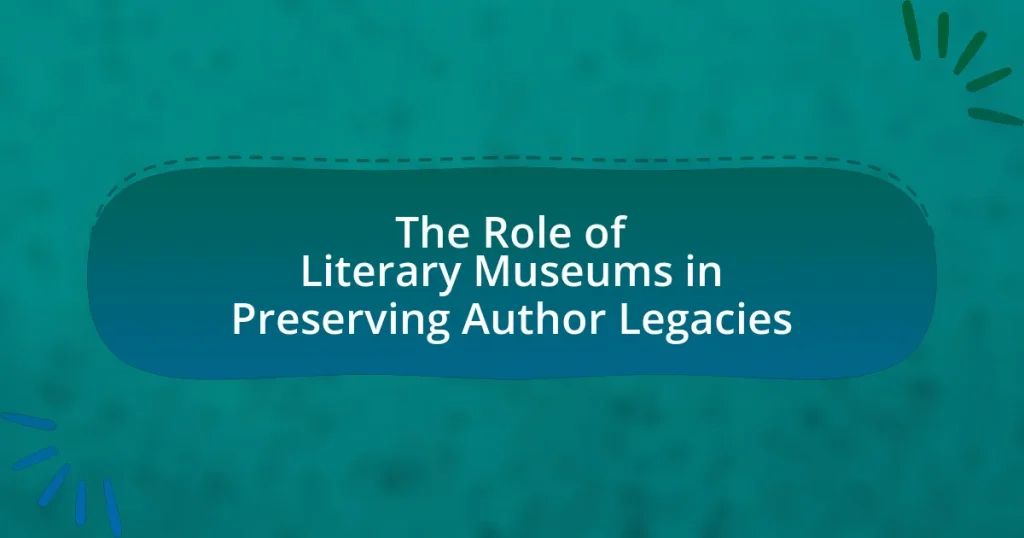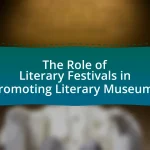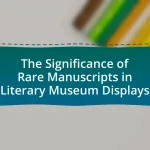Literary museums serve a vital function in preserving the legacies of authors by curating their works, personal artifacts, and historical contexts. These institutions collect manuscripts, letters, and memorabilia that provide insights into authors’ lives and creative processes, thereby enhancing public understanding and appreciation of their contributions to literature. The article explores the types of artifacts typically showcased, the impact of these museums on local communities, and the challenges they face, including funding limitations and the need for technological adaptation. Additionally, it discusses strategies for engaging audiences and promoting literacy through educational programs and interactive exhibits, emphasizing the importance of collaboration with authors and scholars in enriching museum offerings.
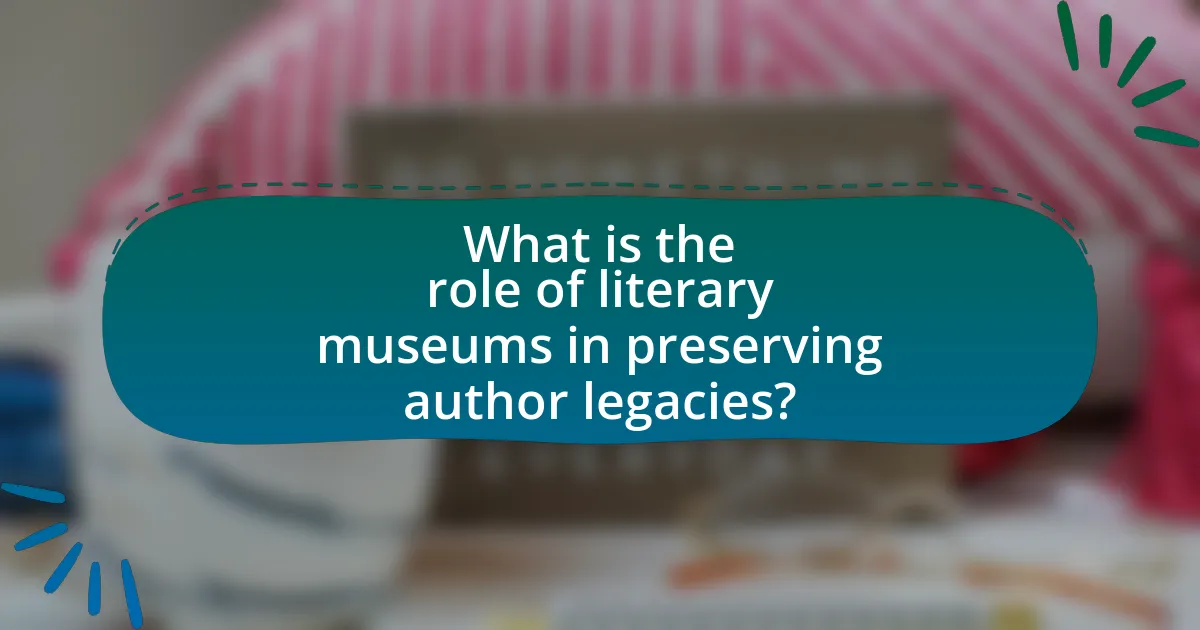
What is the role of literary museums in preserving author legacies?
Literary museums play a crucial role in preserving author legacies by curating and showcasing their works, personal artifacts, and historical context. These institutions collect manuscripts, letters, and memorabilia that provide insight into the authors’ lives and creative processes, ensuring that their contributions to literature are recognized and remembered. For example, the Ernest Hemingway Home and Museum in Key West preserves Hemingway’s personal belongings and manuscripts, allowing visitors to connect with his life and work directly. By offering educational programs, exhibitions, and research opportunities, literary museums foster appreciation for authors and their impact on culture, thereby solidifying their legacies for future generations.
How do literary museums contribute to the understanding of an author’s work?
Literary museums enhance the understanding of an author’s work by providing contextual insights into their life, creative process, and historical background. These institutions often house original manuscripts, personal artifacts, and letters that illuminate the author’s intentions and influences. For example, the Ernest Hemingway Home and Museum in Key West showcases Hemingway’s writing environment and personal belongings, allowing visitors to grasp the context in which his works were created. Additionally, literary museums frequently offer curated exhibitions and educational programs that explore thematic elements of the author’s oeuvre, fostering a deeper appreciation and critical analysis of their contributions to literature.
What types of artifacts do literary museums typically showcase?
Literary museums typically showcase manuscripts, letters, first editions, personal belongings, and photographs related to authors. These artifacts provide insight into the authors’ lives, creative processes, and historical contexts. For instance, manuscripts reveal the evolution of a writer’s work, while personal belongings, such as clothing or writing instruments, offer a tangible connection to the author. Photographs can illustrate the author’s environment and relationships, further enriching the narrative of their legacy.
How do these artifacts enhance the visitor’s experience?
Artifacts enhance the visitor’s experience by providing tangible connections to authors and their works, allowing for deeper engagement with literary history. These items, such as manuscripts, personal belongings, and first editions, create an immersive environment that fosters emotional and intellectual connections. For instance, viewing an author’s handwritten notes can evoke a sense of intimacy and understanding of their creative process, enriching the visitor’s appreciation of the literature. Additionally, artifacts often include contextual information that educates visitors about the historical and cultural significance of the works, further enhancing their overall experience in the museum setting.
Why are literary museums important for cultural heritage?
Literary museums are important for cultural heritage because they preserve the legacies of authors and their works, providing insight into the historical and social contexts in which these literary figures created. These museums house original manuscripts, personal artifacts, and documents that reflect the lives and influences of writers, thereby fostering a deeper understanding of literary history. For instance, the Ernest Hemingway Home and Museum in Key West showcases Hemingway’s personal belongings and manuscripts, allowing visitors to connect with his life and literary contributions. By curating and exhibiting these materials, literary museums play a crucial role in maintaining cultural narratives and promoting appreciation for literature as a vital component of cultural identity.
What impact do literary museums have on local communities?
Literary museums significantly enhance local communities by fostering cultural engagement and education. These institutions serve as hubs for literary heritage, providing access to the works and lives of authors, which can inspire local residents and visitors alike. For example, the Ernest Hemingway Home and Museum in Key West attracts thousands of visitors annually, contributing to the local economy and promoting tourism. Additionally, literary museums often host events, workshops, and readings that encourage community participation and collaboration, thereby strengthening social ties and cultural identity. Research indicates that such museums can increase local pride and awareness of literary history, as seen in studies conducted by the American Alliance of Museums, which highlight the positive effects of cultural institutions on community cohesion and identity.
How do literary museums promote literacy and education?
Literary museums promote literacy and education by providing immersive experiences that engage visitors with literature and its historical context. These institutions often host exhibitions, workshops, and educational programs that encourage reading and critical thinking. For example, the British Library offers educational resources and events aimed at students, fostering a deeper understanding of literary works and their authors. Additionally, literary museums frequently collaborate with schools to create tailored programs that enhance curriculum learning, thereby directly contributing to literacy development in the community.
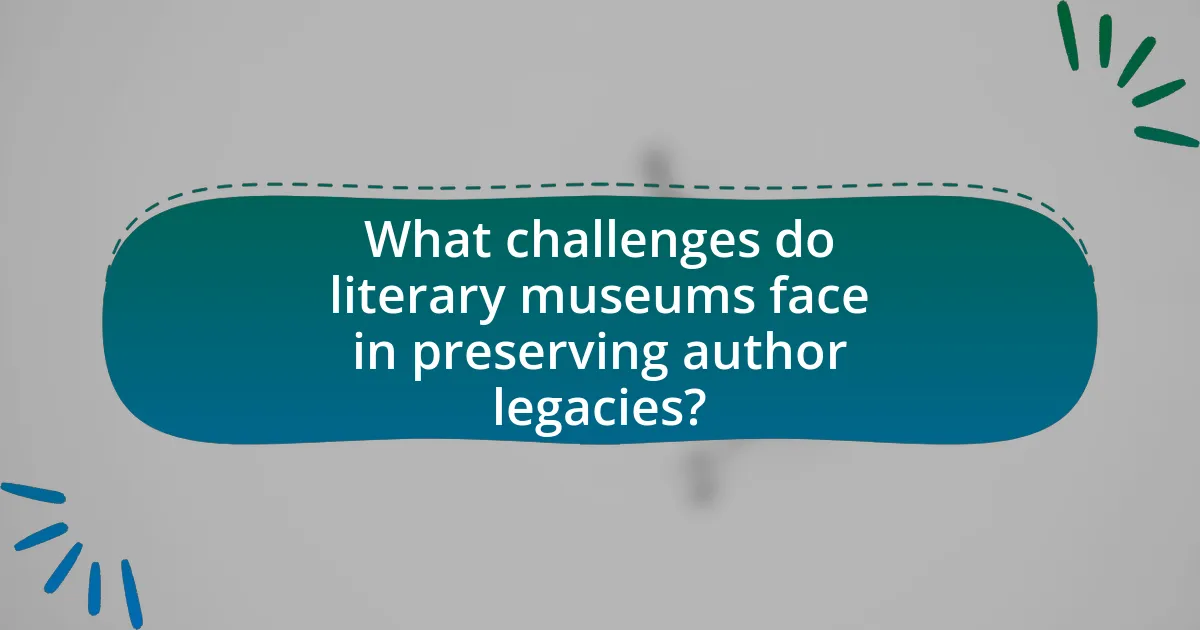
What challenges do literary museums face in preserving author legacies?
Literary museums face several challenges in preserving author legacies, primarily including funding limitations, the preservation of physical artifacts, and the evolving nature of public engagement. Funding limitations often restrict the ability of these institutions to maintain and expand their collections, which can lead to the deterioration of important artifacts. For instance, many literary museums rely on grants and donations, which can fluctuate, impacting their operational stability.
Additionally, the preservation of physical artifacts poses a significant challenge, as items such as manuscripts, personal belongings, and first editions require specialized care to prevent degradation over time. The American Alliance of Museums highlights that environmental factors, such as humidity and light exposure, can severely affect the longevity of these materials.
Finally, engaging contemporary audiences is increasingly difficult as cultural consumption shifts towards digital formats. Literary museums must adapt their strategies to attract visitors, which may involve integrating technology and interactive exhibits to remain relevant. This challenge is underscored by a report from the National Endowment for the Arts, which indicates a decline in traditional museum attendance among younger demographics.
How do funding and resources affect literary museums?
Funding and resources significantly impact literary museums by determining their operational capabilities, programming, and preservation efforts. Adequate funding allows museums to maintain their facilities, curate exhibitions, and offer educational programs that engage the public with literary heritage. For instance, the National Literary Museum in New Zealand relies on government grants and private donations to sustain its activities, which include preserving manuscripts and hosting author events. Conversely, insufficient funding can lead to reduced staffing, limited access to collections, and diminished outreach efforts, ultimately hindering the museum’s ability to fulfill its mission of preserving author legacies.
What are common sources of funding for literary museums?
Common sources of funding for literary museums include government grants, private donations, corporate sponsorships, and membership fees. Government grants often come from local, state, or federal arts councils that support cultural institutions, while private donations can be sourced from individuals passionate about literature and the arts. Corporate sponsorships provide financial backing in exchange for promotional opportunities, and membership fees contribute to the museum’s operational costs by engaging the community. These funding avenues are essential for maintaining the museum’s programs and preserving literary heritage.
How can museums diversify their funding streams?
Museums can diversify their funding streams by developing a mix of revenue sources, including grants, corporate sponsorships, membership programs, and earned income from events and merchandise. For instance, the American Alliance of Museums reports that museums increasingly rely on private donations and partnerships with businesses to supplement traditional funding from government sources. Additionally, implementing innovative fundraising campaigns, such as crowdfunding and online donation platforms, can attract a broader audience and increase financial support. By engaging with the community through educational programs and outreach initiatives, museums can also enhance their visibility and appeal, leading to increased visitor numbers and revenue.
What role does technology play in the preservation of literary legacies?
Technology plays a crucial role in the preservation of literary legacies by enabling the digitization of texts and archival materials. This process allows for the safeguarding of rare manuscripts, letters, and other literary artifacts, making them accessible to a global audience. For instance, institutions like the British Library have digitized millions of pages of historical texts, ensuring that these works are preserved against physical deterioration and are available for research and education. Additionally, technology facilitates the creation of virtual exhibitions and interactive platforms, which enhance engagement with literary works and their historical contexts. This integration of technology not only preserves literary legacies but also democratizes access to cultural heritage, allowing future generations to explore and appreciate the contributions of authors.
How can digital archives enhance access to literary works?
Digital archives enhance access to literary works by providing online platforms where texts can be stored, searched, and retrieved easily. These archives allow users to access a vast array of literary materials from anywhere in the world, breaking geographical barriers and increasing the availability of rare or out-of-print works. For instance, the Digital Public Library of America hosts millions of digitized items, making literature accessible to diverse audiences. Furthermore, digital archives often include metadata and search functionalities that facilitate efficient navigation, enabling users to find specific works or authors quickly. This democratization of access supports educational initiatives and fosters a greater appreciation for literary heritage.
What are the benefits of virtual tours for literary museums?
Virtual tours for literary museums enhance accessibility, allowing a broader audience to engage with literary heritage regardless of geographical limitations. These tours enable individuals who may not have the means or ability to visit in person to explore exhibits, artifacts, and author legacies from anywhere in the world. Additionally, virtual tours can incorporate multimedia elements, such as videos and interactive content, which enrich the visitor experience and provide deeper insights into the authors’ lives and works. According to a study by the American Alliance of Museums, 70% of museums reported increased engagement through digital offerings, highlighting the effectiveness of virtual experiences in attracting diverse audiences.
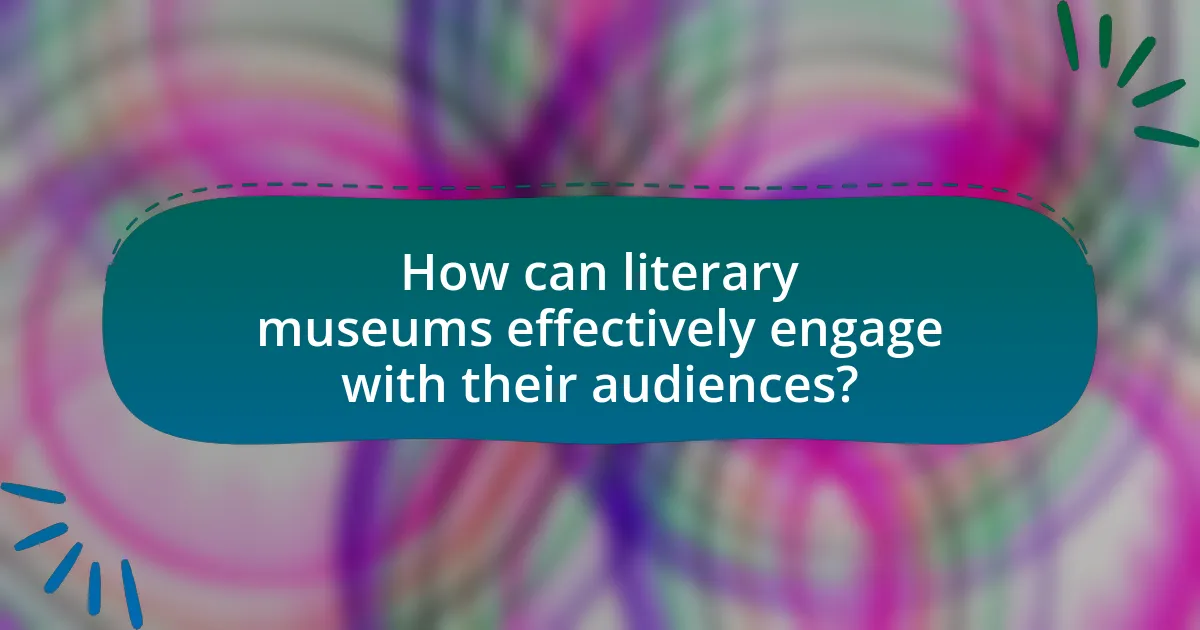
How can literary museums effectively engage with their audiences?
Literary museums can effectively engage with their audiences by offering interactive exhibits, educational programs, and community events that resonate with diverse visitor interests. For instance, incorporating technology such as augmented reality can enhance the visitor experience by bringing literary works to life, allowing audiences to explore narratives in immersive ways. Additionally, hosting author readings, workshops, and panel discussions fosters a sense of community and encourages dialogue around literature. Research indicates that museums that actively involve their audiences in programming see increased visitor satisfaction and repeat attendance, as evidenced by a study from the American Alliance of Museums, which found that interactive experiences significantly boost engagement levels.
What strategies can literary museums use to attract visitors?
Literary museums can attract visitors by implementing interactive exhibits and engaging programming. Interactive exhibits allow visitors to immerse themselves in the literary works and lives of authors, enhancing their experience and connection to the material. For example, the British Library’s “Harry Potter: A History of Magic” exhibition utilized artifacts and interactive displays to draw in over 200,000 visitors. Additionally, hosting author readings, workshops, and literary festivals can create a vibrant community atmosphere, encouraging repeat visits. The success of the Brooklyn Book Festival, which attracts thousands of attendees annually, demonstrates the effectiveness of such programming in increasing visitor numbers.
How can interactive exhibits enhance visitor engagement?
Interactive exhibits enhance visitor engagement by providing immersive experiences that encourage active participation. These exhibits allow visitors to interact with the content, fostering a deeper emotional connection and understanding of the subject matter. Research indicates that interactive elements, such as touchscreens and hands-on activities, can increase retention rates by up to 75% compared to passive viewing experiences. This engagement is particularly effective in literary museums, where visitors can explore the lives and works of authors through interactive storytelling, multimedia presentations, and participatory activities that bring the literary legacy to life.
What role do events and programs play in audience engagement?
Events and programs serve as vital tools for enhancing audience engagement by creating immersive experiences that connect visitors with literary works and authors. These activities foster a sense of community and encourage participation, allowing audiences to interact with the content in meaningful ways. For instance, literary museums often host author readings, workshops, and exhibitions that not only educate but also inspire visitors, leading to increased interest and investment in the literary heritage being showcased. Research indicates that interactive programs can boost visitor satisfaction and retention, as evidenced by a study from the American Alliance of Museums, which found that 70% of participants in engaging programs reported a deeper connection to the subject matter.
What best practices should literary museums follow for successful legacy preservation?
Literary museums should implement comprehensive archival practices, including digitization of manuscripts and artifacts, to ensure successful legacy preservation. Digitization allows for the protection of fragile materials while making them accessible to a wider audience, as evidenced by the British Library’s extensive digital collections that have increased public engagement and research opportunities. Additionally, museums should establish partnerships with educational institutions to facilitate research and promote the authors’ works, similar to the collaborations seen at the Ernest Hemingway Home and Museum, which enhance the understanding of the author’s impact. Regularly updating exhibitions and incorporating interactive elements can also attract diverse audiences, as demonstrated by the success of the National Museum of American Literature in engaging younger visitors through technology and storytelling.
How can collaboration with authors and scholars improve museum offerings?
Collaboration with authors and scholars can significantly enhance museum offerings by integrating expert knowledge and unique perspectives into exhibitions and programs. This partnership allows museums to present more accurate and nuanced interpretations of literary works and author legacies, thereby enriching visitor experiences. For instance, when museums collaborate with literary scholars, they can develop specialized programs that delve into the historical context and thematic elements of an author’s work, making the content more engaging and educational. Additionally, authors can contribute personal insights and anecdotes that bring authenticity to the museum’s narrative, fostering a deeper connection between visitors and the literary figures being celebrated. Research indicates that such collaborations lead to increased visitor engagement and satisfaction, as they provide a more comprehensive understanding of the literary heritage being showcased.
What are effective ways to promote literary museums in the digital age?
Effective ways to promote literary museums in the digital age include leveraging social media platforms, creating engaging virtual tours, and utilizing targeted online advertising. Social media platforms like Instagram and Twitter can showcase museum exhibits and events, reaching a broader audience; for instance, the British Library uses Twitter to share literary content, engaging over 1.5 million followers. Virtual tours allow users to explore museum collections from anywhere, as seen with the National Museum of American Literature, which offers an interactive online experience. Targeted online advertising can attract specific demographics interested in literature and culture, enhancing visibility and attendance. These strategies collectively enhance outreach and engagement, ensuring literary museums remain relevant in the digital landscape.
